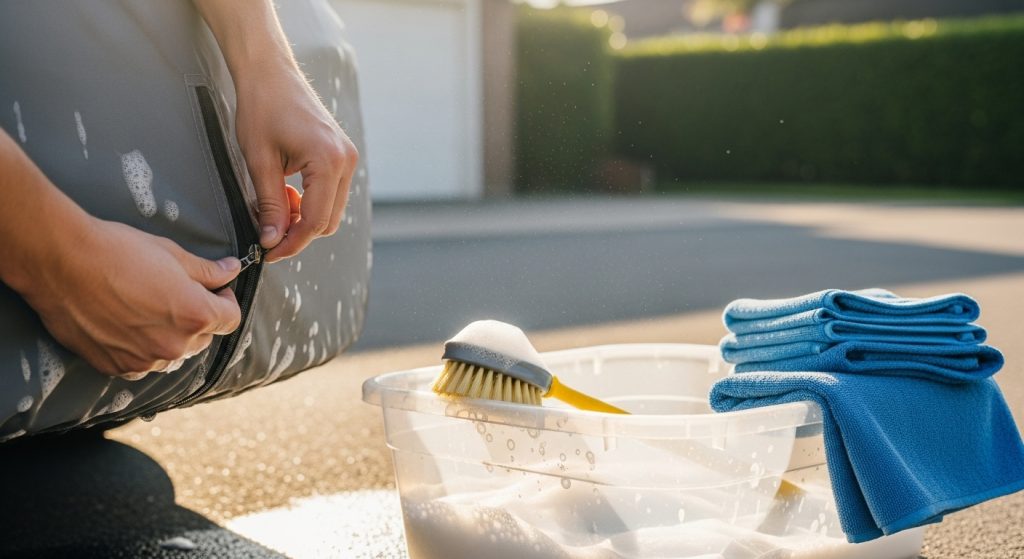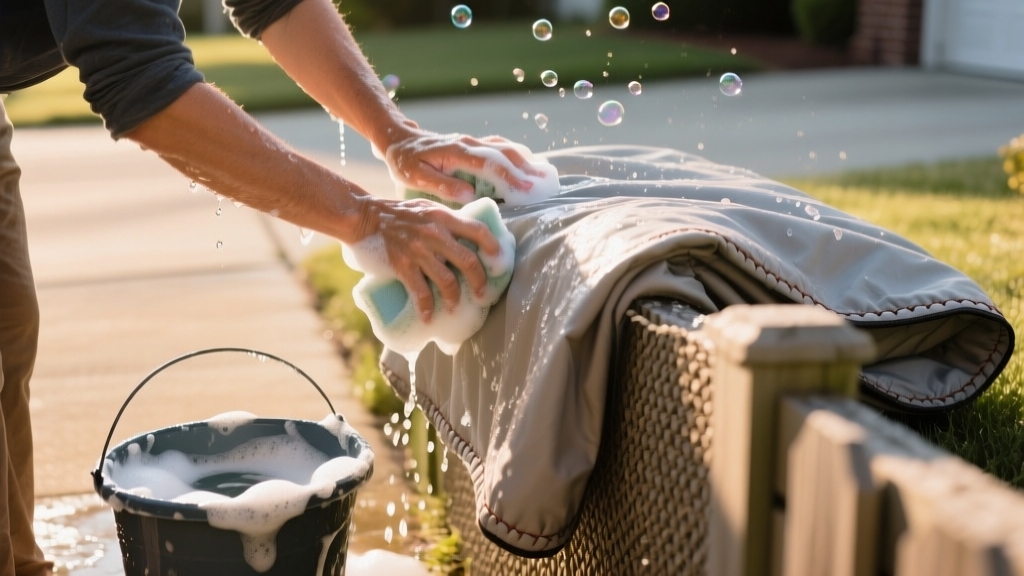To wash your car cover, first inspect it for damage and remove loose debris. If machine washing is allowed, use a commercial washer on a gentle cycle with cold or lukewarm water and mild detergent.
Otherwise, hand wash with a soft brush and mild soap solution. Avoid bleach, harsh chemicals, and fabric softeners. After cleaning, air dry fully in the shade and store in a cool, dry area.
Following careful steps preserves your cover’s durability and protection. Discover detailed tips to maintain its lifespan further.
Key Takeaways
- Inspect the car cover for damage and fabric type before cleaning to choose appropriate methods and avoid damage.
- Shake off loose debris, then pre-treat stains with mild detergent or specialized cleaner before washing.
- Machine wash gently with cold or lukewarm water using mild detergent, or hand wash with a soft sponge and mild solution.
- Avoid harsh chemicals, bleach, fabric softeners, and hot water to protect fabric integrity.
- Air dry fully in the shade, ensuring the cover is completely dry before storing in a cool, ventilated area.
Preparing Your Car Cover for Cleaning

Before you start cleaning your car cover, carefully inspect it for tears, holes, or fabric wear to prevent worsening damage during washing.
Inspect your car cover for any damage before cleaning to avoid making it worse.
Confirm the fabric type—polyester, poly-blend, woven, or non-woven—to select the appropriate cleaning method. It is important to follow manufacturer-specific guidelines for cleaning and maintenance.
Gently shake the cover to remove loose debris, then use a soft broom or brush to eliminate dust and dirt buildup.
Check for stubborn stains and apply a mild detergent or specialized cleaner for pre-treatment.
Verify the manufacturer’s care instructions to avoid damaging the fabric or voiding the warranty.
Spread the cover flat on a clean, dry surface or leave it on the vehicle if hand washing.
Prepare a mild cleaning solution, gather soft sponges or microfiber cloths, and ensure access to clean water for thorough rinsing.
Machine Washing Your Car Cover Safely
Once you’ve prepared your car cover by inspecting and pre-treating stains, you can determine if machine washing is appropriate. Confirm the label permits machine washing and avoid domestic washers with agitators to prevent fabric damage.
Use a commercial washer on a gentle cycle with cold or lukewarm water, adding mild detergent sparingly. Load the cover loosely to ensure effective cleaning without over-agitation.
After washing, air dry the cover fully in shade, avoiding heat sources or direct sunlight. Verify machine washability via manufacturer instructions. Use commercial washers with gentle cycles only.
Employ cold or lukewarm water with mild detergent. Avoid bleach, fabric softeners, and hot water.
Air dry completely, out of direct sunlight and heat sources.
Choosing appropriate cleaning methods can help maintain the cover’s quality similarly to how selecting the right engine oil viscosity preserves vehicle performance.
Hand Washing Techniques for Car Covers
When hand washing your car cover, start by preparing a mild detergent solution with lukewarm water to protect the fabric. Use a soft sponge or microfiber brush to gently clean in sections, focusing on lifting dirt without damaging the material. It is important to avoid harsh household products like bleach or fabric softeners since these can damage the fabric’s protective qualities. For stubborn stains, apply the detergent directly, let it sit briefly, then carefully scrub before rinsing. Proper maintenance and careful cleaning help extend the lifespan, similar to how regular maintenance benefits automotive filters.
Soap and Water
A mild soap and careful hand washing form the foundation for effectively cleaning your car cover without compromising its protective coatings. Use a gentle soap designed for delicate fabrics and mix it in cold or lukewarm water to preserve fabric integrity.
Pre-rinse the cover to remove loose debris, then gently scrub with a soft sponge, working top-down to avoid redistributing dirt.
Apply soap sparingly to ensure easy rinsing and prevent residue buildup.
Thorough rinsing is essential; repeat until no slippery or foamy texture remains.
Choose mild, non-abrasive soap and use cold or warm water, never hot.
Gently scrub with a soft sponge or mitt and rinse thoroughly to remove all soap.
Avoid harsh detergents and excessive soap.
This method maintains water resistance and extends your cover’s lifespan.
For optimal care, consider regular maintenance routines similar to those recommended for other protective gear to prolong durability.
Stain Removal Methods
Although mild soap and water handle general cleaning, tackling stains on your car cover requires targeted methods that preserve the fabric’s integrity. Use a mild, bleach-free detergent diluted in warm water for spot treatment.
Gently scrub stained areas with a soft sponge or a soft-bristle brush to avoid fabric abrasion. Before beginning any stain removal, it is important to identify the material of your car cover to choose the safest cleaning approach. Using products with weather-resistant materials can help maintain the cover’s durability during cleaning.
For stubborn water-spot stains, apply isopropyl alcohol (70-90%) carefully, testing first on a small patch. Avoid harsh chemicals or bleach, which can weaken fibers. After treatment, rinse thoroughly to remove residues, then air dry to prevent shrinkage.
For paint stains caused by contaminants, a diluted vinegar and soapy water solution helps dissolve deposits but must be rinsed off promptly. Regular spot cleaning prevents permanent damage and maintains your car cover’s protective qualities.
Recommended Cleaning Agents and What to Avoid
Since car covers require careful maintenance to preserve their protective features, you should use only mild, bleach-free detergents and cleaners designed for delicate fabrics.
Use only mild, bleach-free detergents made for delicate fabrics to maintain your car cover’s protective qualities.
Avoid harsh chemicals and bleach-based products that can degrade fibers and water-resistant coatings. Opt for gentle all-purpose cleaners like Simple Green or fabric detergents such as Woolite.
Use non-abrasive solutions for tough stains to protect vinyl or fabric surfaces. Proper cleaning also helps prevent lingering odors by reducing residue buildup on the fabric, similar to how deep-cleaning removes smoke residues in vehicles.
- Use mild, bleach-free detergents to maintain fabric integrity
- Choose all-purpose cleaners without harsh chemicals
- Avoid bleach, fabric softeners, and abrasive cleaners
- Use gentle detergents formulated for delicate or synthetic fabrics
- Pre-treat stains with mild, non-abrasive cleaners before washing
Regular maintenance prevents rapid deterioration and preserves vehicle aesthetics, helping your car cover last longer and perform better. proper maintenance
This approach guarantees your car cover’s durability and protective qualities stay intact.
Proper Drying and Storage Methods

When drying your car cover, hang it in a shaded, well-ventilated area to prevent UV damage and ensure even air circulation. Lay the cover flat when possible and flip it occasionally to dry both sides evenly. This practice helps maintain the cover’s protective qualities over time.
Avoid direct sunlight, machine dryers, or heat sources like radiators, as these can weaken fabric or cause deformation. Make sure the cover is completely dry before storing to prevent mold and mildew. Proper maintenance is crucial for preventing contaminants from harming the material’s performance.
Store it loosely folded in a breathable bag or container, placed in a cool, dry, shaded environment away from humidity and pests. Proper ventilation during use and storage helps minimize moisture buildup.
Never store the cover damp, and avoid crumpling it to preserve fabric integrity and extend its lifespan.
Essential Maintenance Tips for Longevity
You should clean your car cover every 2-3 months or more often if it’s visibly dirty to prevent material degradation and protect your vehicle’s paint. Regularly inspect for wear to catch small issues early and extend the cover’s lifespan.
Store the cover in a cool, dry place away from direct sunlight to maintain fabric integrity and avoid mold growth. Consistent cleaning and proper storage are key to extending the life and effectiveness of your cover. Additionally, understanding maintenance and long-term benefits can help you maximize the protection your car cover provides over time.
Regular Cleaning Schedule
Although it may seem tedious, maintaining a regular cleaning schedule is critical to preserving your car cover’s protective qualities and extending its lifespan. Dirt, pollutants, and embedded grime reduce water resistance and can damage both the cover and your vehicle’s surfaces.
Clean your cover at least every three months or more often in harsh, dusty, or polluted environments. Promptly spot-clean contaminants like sap or oil to prevent permanent stains. Always read manufacturer’s instructions before cleaning to ensure proper care. Choosing the right maintenance routine is crucial, as improper upkeep can compromise filtration efficiency.
Key cleaning schedule tips:
- Inspect cover monthly for dirt buildup and damage
- Wash every 3 months or seasonally before or after winter storage
- Spot-clean stains immediately to avoid fabric damage
- Adjust frequency based on environment severity
- Follow manufacturer’s recommended cleaning intervals
Adhering to these practices ensures comprehensive protection and durability.
Proper Storage Practices
Where should you store your car cover to maximize its lifespan? Store it in a cool, dry place with good ventilation to prevent moisture buildup and mildew. Avoid damp basements, direct sunlight, and areas near heat sources. Choosing a storage spot that protects the cover from UV exposure further ensures its material integrity over time. Proper storage also helps maintain the cover’s longevity and performance.
Before storing, ensure the cover is completely dry; moisture promotes mold growth. Fold the cover flat immediately after removal, then fold lengthwise and roll tightly from rear to front to minimize creasing.
Use the manufacturer’s breathable storage bag or a clean fabric container—never plastic bags that trap humidity. Include desiccant packs to absorb residual moisture.
Periodically inspect for mold or damage during extended storage. Keep the cover away from sharp objects and heavy items to avoid tears or abrasions.
Follow these steps to maintain your cover’s protective qualities and durability.
Frequently Asked Questions
Can I Use a Pressure Washer to Clean My Car Cover?
Yes, you can use a pressure washer to clean your car cover, but keep the pressure below 2,200 PSI to avoid damage. Maintain a nozzle distance of at least 6-12 inches and use a 40-degree nozzle for gentle rinsing.
Start with low pressure to loosen dirt, then apply mild soap.
Avoid washing in direct sunlight and fully dry the cover afterward to prevent mildew or fabric weakening.
How Often Should I Wash My Car Cover During Different Seasons?
You should wash your car cover monthly during winter, increasing to every 2-3 weeks if exposed to salt or grime.
In spring, wash monthly, or biweekly if near trees or pollen-heavy areas.
During summer, clean monthly or more after dust storms and rain.
In fall, wash monthly, increasing the frequency to prevent mildew from damp conditions.
Always dry thoroughly and use mild detergents to maintain fabric integrity and protective coatings.
Is It Safe to Use Fabric Protectors After Washing the Cover?
Think of your car cover as a fortress; applying fabric protectors after washing risks weakening its walls. You shouldn’t use fabric protectors unless the manufacturer specifically approves them. They can block breathability, trap moisture, and degrade water-repellent coatings.
Instead, stick to gentle detergents and thorough air drying to maintain performance. Using unapproved protectors may cause mildew, reduce UV resistance, and shorten your cover’s lifespan, compromising the protection it provides.
What Should I Do if My Cover Develops Mold or Mildew?
If your cover develops mold or mildew, start by vacuuming loose spores to prevent spread. Use a soft brush to gently remove dry spots, avoiding abrasives.
Treat affected areas with a mold-specific cleaner or a vinegar solution, applying evenly with a spray bottle. After scrubbing lightly, rinse if needed and dry thoroughly in direct sunlight to kill residual spores.
Store the cover in a low-humidity area to prevent recurrence.
Can I Wash a Car Cover That Has Waterproof Coatings?
Yes, you can wash a car cover with waterproof coatings, but you need to be careful. Use only mild detergents and avoid bleach or fabric softeners, as they can damage the coating. Hand washing is best; gently scrub with warm water and rinse thoroughly.
If machine washing is allowed, use a gentle cycle with low heat and double rinse. Always air dry completely to preserve the waterproof layer and prevent deterioration.
What’s Next After Washing Your Car Cover?
So, now that you’ve mastered washing your car cover without turning it into a soggy mess, remember: treating it like a delicate fabric—not your gym towel—extends its life. Skip harsh detergents and high heat, unless you want your cover to resemble a shrink-wrapped relic.
Follow these precise steps, and your car cover will stay as pristine as your car—well, at least until the next dirt storm hits. Who knew washing could be this technical and thrilling?




